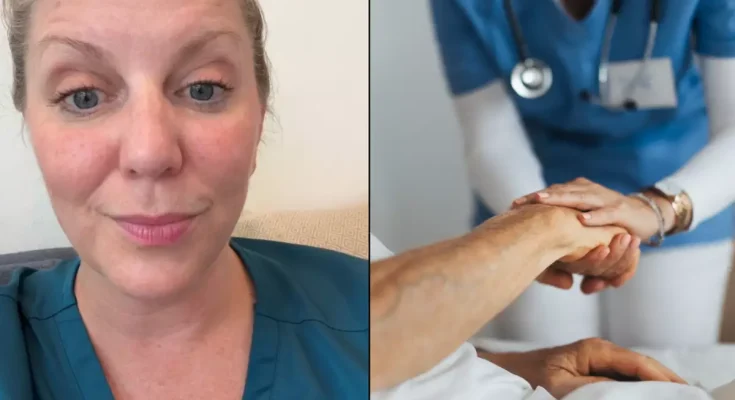Although none of us can predict when, where and why we’re going to shuffle off this mortal coil, this hospice nurse believes that our bodies can do a lot of the talking for us.
There are certain signs and symptoms which would probably be missed by the untrained eye, but for someone like Julie McFadden, they are hard to miss.
The Los Angeles-based nurse has made it her mission to ‘alleviate the fear and stigma around death’ and has garnered more than one million followers on social media with her informative videos on the macabre subject.
She’s educated us on everything from the ‘mess’ you can cause while kicking the bucket, to the ‘unimaginable phenomena’ many of her patients have experienced on their death beds, and the most popular last words she’s heard.
Julie’s seen it all throughout her career as a palliative care nurse and believes that we’d all be able to come to terms with dying a lot easier if we made ourselves aware of exactly what goes down.
.jpg) Julie McFadden wants to get rid of the stigma surrounding death (Getty Stock Image)
Julie McFadden wants to get rid of the stigma surrounding death (Getty Stock Image)
In one of her TikTok videos, she revealed that there tends to be a few pointers which suggest that a hospice patient is nearing the end of their lives – which can occur up to six months before it actually happens.
Julie talked her followers through what happens at each different stage of decline, explaining that different symptoms usually rear their head half a year, three months, one month and a couple of weeks before someone passes away.
She explained that people who are ‘dying a natural death’ tend to get placed in hospice ‘at the six month mark’.
“You will have very generalised symptoms. One, you will be less social. So you’ll be more introverted than extroverted,” Julie said.
“Two, you will be sleeping a lot more. And three, you will be eating and drinking a lot less.
“Literally everyone on hospice, I see this happen to.”
 She explained the signs of death which can occur six months before someone passes away (Getty Stock Image)
She explained the signs of death which can occur six months before someone passes away (Getty Stock Image)
According to palliative care providers My Life Choice, identifying these symptoms quickly allows staff to intervene ‘at the right time to control discomfort and maximise quality of life at the most desired and needed time’.
Julie explained that by the three month mark, ‘you are going to notice more debility’ and a significant deterioration.
“They will be staying in their house most of the time, it’s going to be difficult getting up and just going to the bathroom,” she continued. “Again, sleeping a lot more and eating and drinking a lot less.
“Usually around the one month mark is when people will start seeing ‘the unseen’, the visioning. They’ll be seeing dead relatives, dead loved ones, dead pets, old friends who have died.
“Again, not everyone – but many, many people will start seeing these things at around one month.”
Julie explained that people in her line of work ‘allow the body to be the guide’ and they simply want to make the transition as easy as possible for the patient themselves as well as their loved ones.
“The closer you get to death, the easier it is for healthcare workers who see it all of the time to know that you are getting closer,” she added.
Viewers praised Julie in the comment section for giving them an insight into what to expect.
One said: “Thank you for sharing this, as an ICU nurse we don’t see the long term decline.”
Another wrote: “Nurse Julie, you are the best.”
A third added: “Wow that was exactly what my mum did!”
And someone else commented: “You are so knowledgeable, thank you for sharing.”



